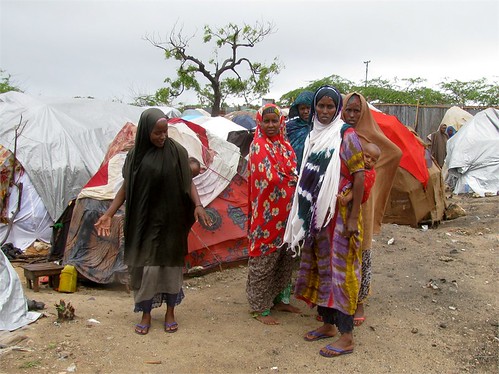
Women in the Waberi District of Mogadishu, Somalia where they have re-located to receive drought relief from international humanitarian organizations. Despite the reports of famine fewer people are arriving in the capital., a photo by Pan-African News Wire File Photos on Flickr.
SOMALIA: Number of drought-displaced arriving in Mogadishu "dropping"
Although the number of drought-displaced families reaching Mogadishu has dropped, the situation in the Afgoye corridor is deteriorating, aid officials say
BAIDOA, 8 August 2011 (IRIN) - Humanitarian officials say the number of drought-displaced families arriving in Mogadishu, Somalia's capital, has dropped in the past two weeks as more and more families cross the border into neighbouring Kenya and Ethiopia, while others go to the Al-Shabab-controlled town of Baidoa, in the south-central Bay region.
"Between 15 June and 15 July, we had about 500 families reaching Mogadishu every day but the number has since decreased to about 250 families daily," said Ahmed Abdi Muhumed, a programme manager for Muslim Aid in Somalia, a UK-based NGO.
Muhumed said Baidoa, 250km northwest of Mogadishu, was now home to between 6,000 and 7,000 drought-displaced families. Baidoa, capital of the Bay region, is the third-largest town in south-central Somalia, after Mogadishu and Kismayo.
So far, Muhumed said, the NGO Islamic Relief and the UN Children's Fund (UNICEF) were the only two aid organizations active in Baidoa. He added that Muslim Aid would begin operations there this week.
"We have assessed and found that between five and 10 children are dying in Baidoa daily due to starvation and diseases including malnutrition and diarrhoea; we are going to start food distribution and feeding this week," Muhumed said.
According to the UN, an estimated 300,000 people are in humanitarian emergency in Bakool and Lower Shabelle regions in south-central Somalia, two of five regions the UN has categorized as experiencing famine.
Muhumed said at least 150,000 out of the 300,000 people were at risk of starvation.
Nearer Mogadishu, in an area known as 50km, thousands of families are also at risk of starvation, according to Muslim Aid.
Muhumed said: "In the first days of our operations in and around Mogadishu, we found that many people preferred going to main urban centres, so we divided our operation into two: first, in 50km we distributed food and shelter to 2,000 families, then we distributed food to 3,000 families in camps for the internally displaced in Mogadishu."
Afgoye
The situation is deteriorating in the Afgoye corridor, west of Mogadishu, where up to 400,000 internally displaced persons (IDPs) have sought refuge.
"The drought displacement has caused a livelihood emergency in Afgoye corridor because the numbers of new arrivals are so high and this has made the situation difficult even for the displaced who have been here for long," Muhumed said.
Al-Shabab authorities in Baidoa recently told journalists that only US$3,000 was needed to feed the drought-affected in the town, adding that Somalis in the diaspora had sent some money to help the vulnerable families.
At the same time, members of the Transitional Federal Parliament of Somalia in Bay and Bakool regions have expressed concern about the humanitarian crisis in their areas.
"We know that about 6,000-7,000 families are now in Baidoa; they have nothing," Mohamed Abdi Ganay, an MP from Bay region, said. "Most of the people are from Ufurow, Qansah-Dheere, Dinsor and Bakool areas. The ICRC [International Committee of the Red Crescent] has distributed food to 780 families but many others are still suffering."
Speaking on behalf of MPs from the two regions, Ganay said they were calling on Al-Shabab to allow humanitarian agencies access to the drought-displaced in the Bay and Bakool regions.
"So far, this access has not been granted; we are discussing with the government to see if we can find solutions," he said.
This report does not necessarily reflect the views of the Pan-African News Wire.
No comments:
Post a Comment